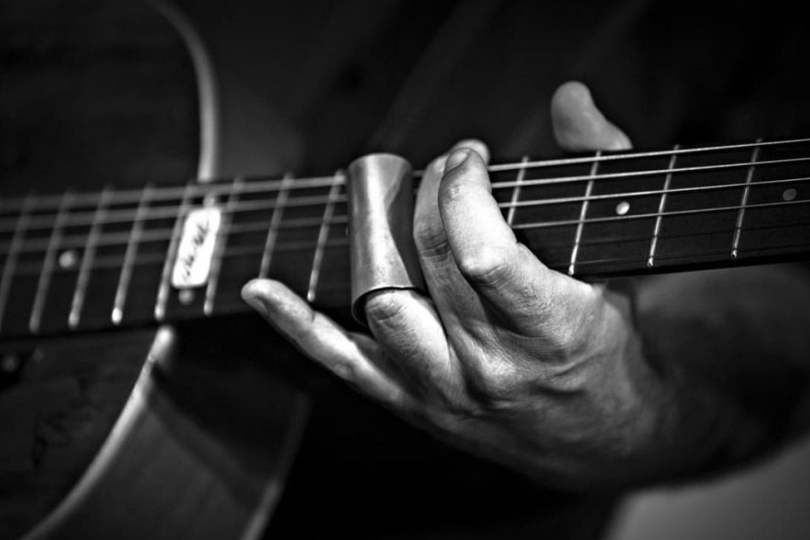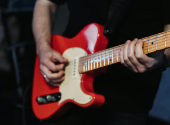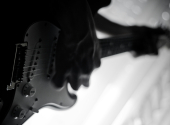
(Un)usual Guitar Techniques #11: Slide Guitar
In today's episode of Guitar Techniques, we will once again examine the fascinating space between semitones. Slide guitar offers many ways to make the journey from one tone to another more interesting, and if you've ever envied fretless bassists, this technique is just right for you. We'll also take a look at Hawaii, where this style of playing originated, and learn about a strange little thing called a bottleneck.
When I was about fifteen, I got George Harrison's double album All Things Must Pass for Christmas, and I listened to it over and over for the whole holiday season (when I wasn't sledging and skating). Starting to write this article about a slide guitar in a small cottage in the middle of a frozen landscape, this memory comes back and the first sliding notes of "If Not For You" echo in my head.
Historical overview
However, the origins of slide guitar date much further back in history – we have to go to Hawaii. Sometime around 1885, a boy named Joseph Kekuku picked up a piece of iron lying by the railway tracks and discovered that he could make fascinating sounds by running it over the strings of his guitar. This method of playing quickly spread throughout Hawaii, and by 1893, Hawaiian guitarists introduced it at the World's Fair in Chicago. Thirty years later, in 1923, the first blues recording using slide guitar was made in New York. Called "Longing for Daddy Blues," it was recorded by guitarist Sylvester Weaver, this time using a knife. Slide guitar became firmly established in the blues and country over the following decades.
With the expansion of the electric guitar in the 1960s and 1970s, this style of playing made its way to rock and popular music in general. Guitarists were still figuring out what the new instrument had to offer, experimenting with sound and playing techniques. Not surprisingly, they took up the bottleneck and explored its uses and sonic possibilities. One could say that since then, the slide has been one of the means of expression for solo guitarists of all genres.
Bottleneck
The typical sliding sound of a slide guitar is created by a piece of hollow tube called a slide, or bottleneck, which the guitarist wears on a finger of their left hand. It can be made of glass, metal, porcelain or other materials, each of which has slightly different sonic properties. The metal slide has been used by guitarists since the beginning, originally it was just a piece of sheet metal or a knife, and this material is still popular, especially in the blues. Metal bottlenecks have a sharper, more aggressive tone and great sustain and have been used by guitarists such as Muddy Waters, Rory Gallagher and Joe Bonamassa.
Glass bottlenecks, in this case really reminiscent of the neck of a bottle, are on the other side of the sound spectrum. Their tone is "softer, warmer", and is commonly associated with electric guitars. The glass slide is used by Bonnie Raitt, Ry Cooder, and Jeff Beck, as well as slide guitar legends Duane Allman and Derek Trucks. Duane Allman even used a cold medicine bottle as a slide for a long time, and Jim Dunlop now makes a signature model bottleneck based on this exact bottle.
Somewhere in the middle is the ceramic slide, which, although it doesn't have such a long history, offers a good compromise between the two previous variants. It is used by Billy Gibbons and Joe Perry, for example.
How to slide?
To begin with, it's important to say that while some guitar techniques are pretty straightforward regarding how to play them correctly, with slide guitar the "correct" way is very individual. For example, the very first question that probably comes to mind – which finger should we have the slide on – doesn't have a perfectly straightforward answer. Usually, the ring finger is recommended, but it depends a lot on your playing technique and you will also come across the use of other fingers. The middle finger gives you much better control of the tone, the little finger allows you to reach further and leaves you with three fingers for playing tones without a slide. The ring finger therefore seems to be a good compromise, at least to start with.
But there are a few basic rules that can help you make your slide guitar sound the way it should. The first important question is where to place the slide on the fingerboard. Here, the answer is clear – above the frets. Because if you place the slide where you press the string, that is, in the middle of the space between the frets, the tone will be flat.
Secondly, you might wonder how much to press the bottleneck on the strings. This is where you can go back to the episode about flageolets – the contact of the slide with the string should be similar to when you play natural flageolets, you definitely shouldn't squeeze the strings. This can prove to be quite a tricky task, especially if you have a guitar with a low action (the strings are very close to the fretboard). In this case, the space between "too little" and "too much" pressure on the strings is very narrow. So don't be discouraged by the initial failure; however, if you can get a guitar with a higher action for practising the slide technique, you'll find it easier.
The last thing to watch out for is string muting. We covered this in the last episode of Guitar Techniques, and it will come in very handy when playing with a bottleneck. Be sure to gently place the fingers that aren't currently playing behind the slide over the full height of the fingerboard to dampen any unwelcome rattling and overtones.
Tune alternatively
Although not exactly a "guitar technique", alternative tuning is inherent to slide guitar. That is, the kind of guitar tuning where the harmony of the open strings produces a ("useable") chord. Thus, both the open strings and the barre chord on any fret (and of course the slide) sound "good" right away. In addition, you'll find most of the usual blues licks easier to play. If you want to play the slide mainly in solos, it's a good idea to learn how to use it in standard guitar tuning. Even so, you might enjoy playing a classic blues in something other than the usual tuning.
There are many possibilities that would deserve a separate article. The most common tuning is to the E chord (from bass to treble E-B-E-G#-B-E), followed by D (D-A-D-F#-A-D ) and G (D-G-D-G-B-D). If, like me, you use a guitar with a Floyd Rose locking tremolo, you are very likely to avoid this tuning exercise. However, alternative tuning and slide experiments are some of the reasons I would consider getting another guitar. After all, it offers many interesting harmonic possibilities for solos and for music-making in general.
If you're passionate about slide guitar, I suggest setting aside one guitar specifically for this technique – ideally an instrument that has a higher action and you can keep it tuned to your favourite open tuning. You can even use an older guitar that you don't feel comfortable playing otherwise.
Like string bending or vibrato, slide guitar brings a unique emotion to your playing that results from a certain inaccuracy of the note that is played. This is because it resembles a sung tone, which also vibrates around certain frequencies, but is never completely homogeneous. So if you want to bring liveliness and a strong emotional charge to your solos or riffs, you can try what happens when you use a bottleneck.
If you have found an error or typo in the article, please let us know by e-mail info@insounder.org.





